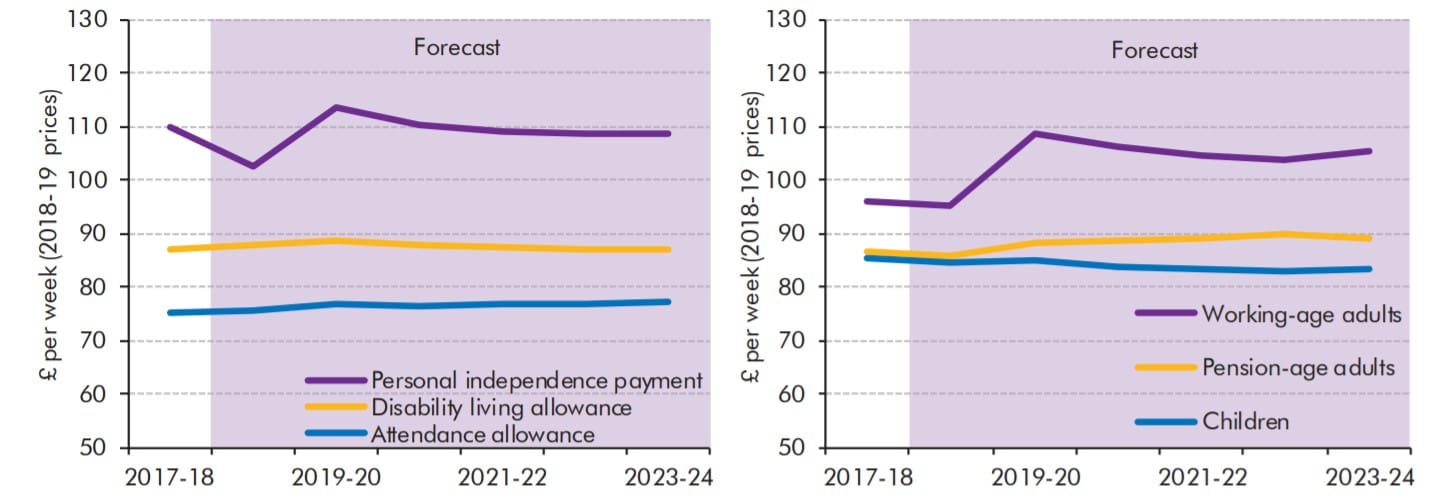The Department for Work and Pensions (DWP) is set to cut people’s disability benefits again. The move, not reported by the media, means that it’s been cutting some disabled people’s support for over a decade – despite claiming otherwise.
The DWP: chronic mismanagement
The Office for Budget Responsibility (OBR) recently published its welfare trends report for January 2019. It states that it:
reviews the effects of recent disability benefit reforms on spending, in particular the transition from Disability living allowance (DLA) to Personal independence payment (PIP).
The media widely reported its analysis. It focused on the fact that the OBR said that PIP cost more than DLA. This was despite the DWP saying that it would save money. As the Guardian said:
the… [DWP] dramatically under-estimated the costs of rolling out the… (PIP) system, which began to replace… (DLA) in 2013.
A saving of £2bn was expected by 2018, but that has since been revised to an over-spend by £1.5bn to £2bn…
But this is not the whole story. Because buried in the OBR report were its forecasts for DWP PIP and DLA spending up to 2023/24. At the time of publication, all the media missed this. But it’s actually the most damning part of the report, as it shows cuts are coming in real terms.
More cuts
The OBR says that in cash terms (that is, actual money spent), the DWP will be increasing its spend on PIP and DLA up to 2023/24. It noted:
average PIP awards are expected to rise by 10.4 per cent, average DLA awards by 12.0 per cent… But thanks to the caseload shifting towards PIP, where average awards are higher, average overall disability benefit awards rise faster than any of the three benefits on their own, by 18.3 per cent.
But the OBR crucially notes real terms spending. This is where it adjusts future benefit spending, to account for rising costs of living (inflation). It bases this on 2018/19 prices.
What the OBR says is that by 2023/24, average PIP awards will actually fall by 1.3%. It notes:
average… DLA awards rise by… 0.1 per cent… But average PIP awards fall by 1.3 per cent. By age group, average awards increase for the working – and pension-age – by 9.9 and 2.5 per cent respectively – while child average awards fall by 2.1 per cent.

The OBR’s statement is damning. This is not least because PIP is supposed to “help” sick and disabled people with the “extra costs” they face. But it’s also damning because the DWP has already cut disability benefit spending.
Cut and cut again?
As The Canary revealed, the DWP cut DLA in real terms between 2009/10 and 2016/17. It worked out at an average loss of £121.58 per claimant. This is despite the DWP claiming it had increased DLA claims in real terms. The OBR report seems to confirm The Canary‘s analysis.
So, the OBR is saying that DLA average awards will increase in real terms by 2023/24. But this is not the whole story. The DWP is moving DLA claimants to PIP, due to it phasing DLA out. To be clear, some claimants may see a cash increase in their payments. But in reality, if you were on DLA, on average you would have seen a real-terms cut up to 2016/17. Then, if the DWP moves you onto PIP in 2018/19, you’ll see another real-terms cut by 2023/24. So, regardless of whether the DWP gives you a higher cash payment on PIP, it has cut the money you’re entitled to in real terms under both benefits.
The DWP says…
The DWP told Disability News Service:
Our priority has always been to ensure disabled people get the support they’re entitled to. PIP is designed to focus support on people with the greatest needs and that’s happening, with 31 per cent of people getting the highest level of support, compared to 15 per cent under DLA. As with any major new benefit we have been flexible and adapted our approach, and we continue to make improvements to ensure PIP is working in the best way possible.
Reckless
But OBR forecasts show the DWP has “adapted” nothing when it comes to real-terms benefit spending. Over the years it has left sick and disabled people with less and less money to live on. Sadly, with Brexit in chaos and the possible effects of that on inflation unclear, the situation may end up being even worse than the OBR says.
Featured image via The Canary and UK government – Wikimedia
















